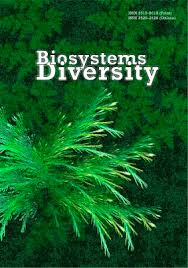Patterns of vegetation succession in abandoned fields in semi-arid conditions
Patterns of vegetation succession in abandoned fields in semi-arid conditions
Author(s): L. P. BorovykSubject(s): Agriculture, Energy and Environmental Studies, Sociobiology
Published by: Дніпропетровський національний університет імені Олеся Гончара
Keywords: secondary succession; nature reserve; restoration of steppe; successional series; alien species;
Summary/Abstract: Successions in old fields were studied on the example of the Starobilski steppes within Luhansk Oblast (Ukraine), region located in the basin of the left tributaries of the Siversky Donets, in the southern spurs of the Central Russian Upland. Stationary surveys were conducted in the Striltsivsky Steppe affiliate of the Luhansk Nature Reserve, with 269 ha of old fields (26% of the area) in its territory. Geobotanical releves were performed in 26 plots of abandoned fields, constant monitoring surveys were carried out in 15–27 year-old abandoned fields in the territory of the Reserve and 5–15 year-old abandoned fields in the territory of its buffer zone. In total, the itinerary and detailed surveys were conducted for about 50 plots of abandoned fields. The restoration of the steppe communities was seen only in the plots where grazing and/or mowing took place, which prevented the formation of dense litter and distribution of woody species. The long domination of rhizome grasses (Elytrigia repens) were characteristic in conditions of moderate-level disturbance (in the reserve), transition to the domination of bunchgrasses (Festuca valesiaca) was seen at the age of around 25 years, during the transitional period (20–25 years) communities with unstable structure formed, comprising E. repens, F. valesiaca and forbs (Achillea pannonica and Fragaria viridis). Duration of the stage of segetal and ruderal species in the sites under low effect was 10 years, the communities of unstable structure formed at the age of 5–10 years. In the conditions of stable moderate and high effect of grazing (high disturbance), we observed formation of bunchgrass communities at the age of 15 years. In the unused plots, we saw formation of phytocoenoses of shrubs at different stages of succession, starting from 10 years. The most abundant group of such kind comprised thickets of Ulmus pumila (with E. repens and Poa angustifolia in the herbaceous layer) and Prunus stepposa. The peculiarity of contemporary processes in the abandoned fields related to exacerbation of the vegetation’s anthropogenic transformation is distribution of alien tree species from plantations, the most aggressive of which are Ulmus pumila, Fraxinus lanceolata, Acer negundo, Elaeagnus angustifolia. The peculiarity of the succession processes in the region of studies was the domination of species of broad ecological spectrum, characteristic for abandoned fields of northern forest-steppe regions (Bromopsis inermis, Calamagrostis epigeios, Poa angustifolia, Fragaria viridis) and southern steppe regions (Bromus sguarrosus, Anisantha tectorum, Achillea pannonica, Artemisia austriaca), certain communities form dependent on the climatic conditions and type of land use in the period of succession in particular plots.
Journal: Biosystems Diversity
- Issue Year: 28/2020
- Issue No: 4
- Page Range: 357-363
- Page Count: 7
- Language: English

